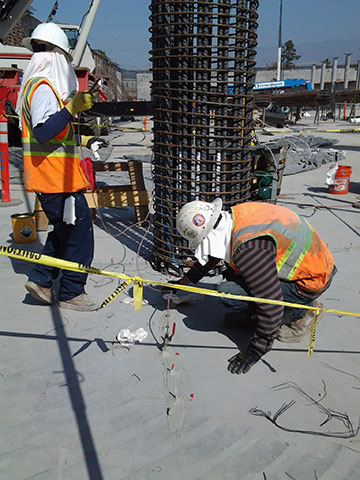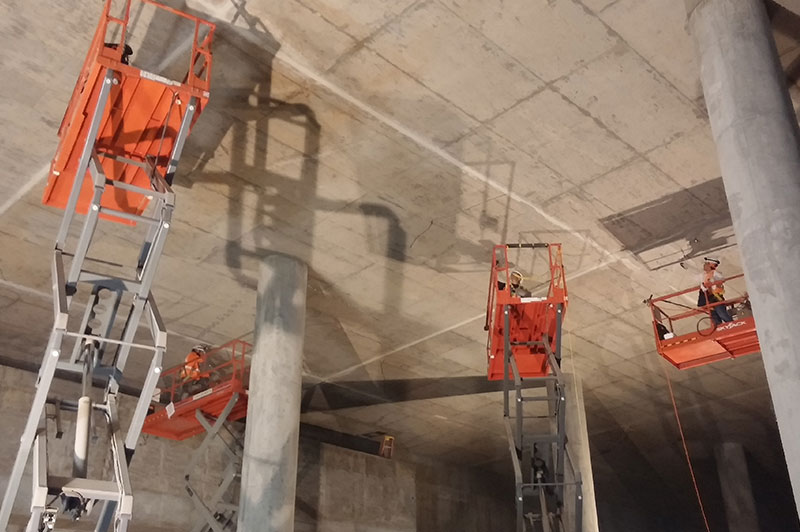Pour, crack, fill, repeat.
It might sound as if this is a recipe for baked goods, but for Angelus Waterproofing & Restoration, Inc., it was the daily schedule for a year-long construction cycle. The underground Silver Lake Reservoir, built by the Los Angeles Department of Water and Power, covers an area the size of six or seven football fields in northern Los Angeles. There are a lot of people living there so it’s a big structure, and it needed to be repaired as it was being poured.
“The concrete pours were so hot that they
cracked,” explained Shaun Geiger, CEO and co-owner of Angelus Waterproofing
& Restoration, Inc., the contracting company set to the repair task. On a
reservoir that can hold 55 million gallons (208.2 L) of potable water, that’s a
lot of cracks. No wonder it would take extra crew members, extra time, extra
money, and a whole lot of epoxy injection material!
Make It Stronger
The
cracks could be found throughout the concrete. They covered the walls, floors,
columns, and roof. Angelus Waterproofing was hired to come out and fill
.004-inch (0.010 cm) cracks with resin. “They were pouring it so fast, that it
would immediately start cracking,” Geiger said. It may seem counterintuitive to
repair a structure as it’s being built, but it was done per city
specifications, and to the Angelus Waterproofing crew, it made sense. In fact,
Geiger explained that it added structural integrity to the concrete.
“The epoxy injects that resin through the
entire crack,” said Geiger. “It cures to a hardness that’s greater than
the concrete. It’s actually stronger than before.” He likened it to a broken arm
where the newly healed bone is often stronger than the original bone around it.
In an area known for earthquakes, strength and integrity were high priorities.
That meant that the Angelus Waterproofing crew’s role was a crucial one.
In the Groove
The
concrete was poured into cooling forms, and then it was up to Angelus
Waterproofing to follow behind and fix it. Their portion of the job started in
October 2013 and finished by October 2014. In that time, according to Geiger,
the Environmental Protection Agency (EPA) mandated that all reservoirs would need
to be covered by the end of the calendar year. So the schedule, and therefore
the construction, sped up!
 “Originally we had 10 people working
on it, but the [concrete] contractor was falling behind schedule, so they
wanted us to accelerate our schedule,” Geiger said. “We doubled it to 20 guys —
a lot of overtime, weekend work.” It helped that they also had four pumps to
utilize. According to Stephan Claus, president and other co-owner of Angelus
Waterproofing, they were hired over other contractors because of the amount of
equipment they had on hand and results that were shown during pre-contract
mockup. The city liked what they saw and hired the Angelus Waterproofing crew.
“Originally we had 10 people working
on it, but the [concrete] contractor was falling behind schedule, so they
wanted us to accelerate our schedule,” Geiger said. “We doubled it to 20 guys —
a lot of overtime, weekend work.” It helped that they also had four pumps to
utilize. According to Stephan Claus, president and other co-owner of Angelus
Waterproofing, they were hired over other contractors because of the amount of
equipment they had on hand and results that were shown during pre-contract
mockup. The city liked what they saw and hired the Angelus Waterproofing crew.
Once
hired and on site, the crew got right into the groove. They started by brushing
or blowing off any dust on the concrete crack. Then they troweled on a layer of
Sika 31 epoxy paste, which is “kind of like peanut butter,” Geiger explained.
It’s a two-part material that is mixed and applied onto the crack in about a
two-inch (5.1 cm) stripe. They put ports from SealBoss into the material about
every 12 inches (30.5 cm). Once the paste was dry, the crew came back in to
apply Sika 35 Epoxy Injection Resin, which instead of peanut butter has a maple syrup-like consistency
according to Geiger. They used epoxy injection pumps from SealBoss and Lily and
wore hard hats, gloves, goggles, safety vests, and 3M ventilating masks at all
times and harnesses when working on the H&E scissor lifts.
Finishing off the injection sites was a
task. “We start at bottom port, attach the injection hose
to the port, and pressure inject the Sika 35 resin until it will ooze out the
next port and we put a cap on there,” Claus said. They continue the same
process until the crack has been filled. They worked their way up the crack —
covering a total of about 35,000 linear feet (10,668 m) and using more than
3,000 ports. “We bought every bit of Sika injection resin and paste material in
California,” Claus said. “They were shipping
it in from the Western United States to keep
the job going.” Thank goodness for reps you can count on and a good cash flow,
especially considering the amount of material, money, and two-month-long change
orders that were needed throughout the job. “This job was a huge cash crunch,
but we figured it out,” Geiger said.
To finish the process, the crew came in
the day after the previously injected resin had a chance to dry and shaved off
the paste and ports. They did this with scrapers and a torch (where necessary).
They disposed of all leftover scraps and left in their wake a clear epoxy
finish flush with the newly poured concrete surface.

Remarkable Repair
The
size and pace of the job alone would have been enough to break some crews, but
not the “injection guys” from Angelus Waterproofing. And on top of that, the
fact that it’s in an enclosed area with poor lighting, poor ventilation, and
100° F (37.8° C) temperatures made for a challenging project for sure. For
their crew’s safety, they supplied everyone with Gatorade and implemented mandatory
breaks every two to three hours.
“We’ve never done a job like this,” Geiger
stated. “It started off like a little area and we did it — boom. Then do this
area. ‘We’ll field-verify it and give you a change order.’ It started off that
way and went throughout the job.”
But
when all was said and done, the crew from Angelus Waterproofing and
Restoration got the job done safely and per the city’s specs. Even for a crew
whose work has been featured in the Los Angeles
Times in the past, this job was unique. It took 20 crew members and 12
months, but they got it done and now have another job for the books!